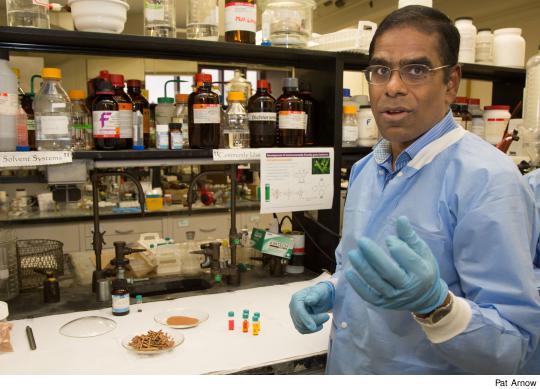Making more sustainable materials from renewable and plant-based substances, and using those substances to solve real-world problems is the focus of City College chemistry professor George John’s soft materials research group. His lab’s projects have ranged from a gel that would solidify oil to help clean waterborne spills, to developing healthier substitutes for transfats by solidifying olive oil, canola oil or other vegetable oils.
 |
A current focus is developing the chemical makeup for a sustainable lithium-ion (Li-ion) battery, one that does not use toxic heavy metals and would thus be better for the environment. John’s been working with fellow scientist Pulickel Ajayan at Rice University in Houston. Ajayan is spearheading the electrochemistry end of the project, while John looks for the toxic and expensive cobalt component of lithium-ion batteries.
Li-ion batteries are used in many common personal electronics, from cell phones to laptops to digital cameras. According to Nature’s online publication Scientific Reports, “thirty percent of globally produced cobalt is channeled into battery technology.” The batteries powering personal electronics are usually made with cobalt or other heavy metals; an EPA study published last year found that batteries using nickel and cobalt have the highest potential for environmental impacts including “resource depletion, global warming, ecological toxicity, and human health impacts.”
A Green Battery
Battery production affects climate change because it is so energy-intensive, starting with what John says is an expensive mining process. Once the cobalt is extracted from the earth, creating the battery and later recycling it safely are expensive and energy-consuming. For every kilowatt hour of energy that the battery produces, the production and recycling process for the battery pumps 72 kilograms (more than 150 pounds) of carbon dioxide into the air. In 2010 alone, according to scientists working to develop the battery, nearly 10 billion lithium-ion batteries had to be recycled.
The Right Chemistry
“If we can conceptually demonstrate that we can create a Li-ion battery from materials that are easily available and don’t need to be mined and refined, that is interesting,” John told Clarion. “We found one family of molecules that can coordinate and make a nice complex with the lithium.”
The family of molecules John refers to comes from the purpurin extract derived from the root of the madder plant. It is commonly used to make a fiery red dye. Somewhat surprisingly, purpurin seems a good candidate to function as a battery’s electrode on Li-ion complexation: the molecular structure of purpurin is adept at passing electrons back and forth, as required in a battery.
“This particular molecule was used for the last 4,000 years to dye clothes,” John told Clarion. “We see this red color all the time, but we never thought this could be potentially useful for a battery one day.”
A purpurin electrode is made with a few basic steps. At ambient conditions, purpurin is dissolved into an alcohol solvent and then lithium salt is added. When the lithium ion binds with the purpurin, the color of the solution changes slightly, from yellow with a red tinge to pink. With no heavy metals involved, a purpurin-based battery would be easy to dispose of safely.
Relatable Experiments
John’s research team has conceptually demonstrated that they can create a ‘green’ battery with purpurin, and now they’re working to build a prototype in the next year or two. The goal is to produce a green battery for personal electronics that can be made widely available. If they succeed, the benefits of the project would be exciting.
Experimental work like this is also useful to John in the classroom for teaching the mechanics of organic chemistry.
“Organic chemistry is something related to our lives, our daily lives. It is nothing alien,” said John. Talking with undergraduates about experiments like those in the green battery project sparks their interest and deepens their involvement in the learning process, he says: “The students who are coming to us are quite excited because these experiments are things that they can easily relate to.”
Research and Teaching
John, whose past work experience was heavily research-focused, came to CUNY because he wanted to teach. It’s a balance that he’s glad to have today; John says one of the best benefits of his job is being surrounded by a “diverse [and] interesting community,” in terms of both the students and the faculty at City College.
Prior to coming to CCNY 10 years ago, John was a research faculty member at Rensselaer Polytechnic Institute in Albany. Before that, he worked at universities and research institutes in Japan, the Netherlands and India, where he completed his graduate work at the National Institute for Interdisciplinary Science in Kerala. But working on sustainable design through plant-based materials has been a constant in John’s work.
“I started this kind of chemistry when I was a graduate student,” John told Clarion. “At the time, it was not in fashion to be
‘sustainable’ and ‘green.’”
A core part of John’s approach is looking to create new materials using very simple chemistry or chemistry that already occurs in nature. It’s an approach he imparts in discussing his work with his students, whether he’s describing an antibacterial paint developed from vegetable oil or how to release a drug using material from a fruit and an enzyme.
“Almost any scientist is thinking outside the box,” John said. “We are thinking of how to use natural, easily available material to make something interesting.”

